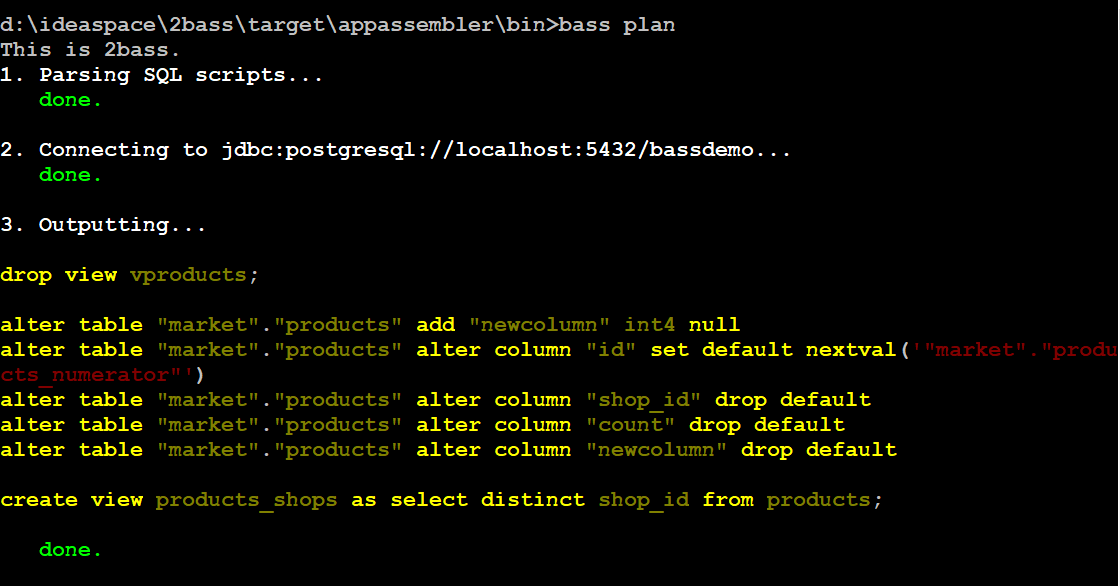2BASS
2bass is a database configuration-as-code tool that utilizes the concept of idempotent DDL scripts.
This is a derivative of Celesta project, in particular, it uses CelestaSQL as database definition language. Documentation for CelestaSQL is currently in Russian only, but syntax diagrams for the language are self-explanatory.
Current status
This project is in development phase. For binaries see releases, or see [How to build] if you want to build the freshest binary yourself. If you want to contribute (suggestions/feature requests are very welcome!) please feel free to contact any of the contributors.
How to build from sources
You will need JDK 8 and Maven in order to build 2bass. If you want to run tests during the build, you will also need Docker to be installed. To build without compiling and running the tests, run
mvn package -Dmaven.test.skip=true
The result of the build will be target/2bass-<VERSION>-bin.zip file.
How to install and run
Prerequisites: JRE 8. Unzip target/2bass-<VERSION>-bin.zip file and make bin folder availiable on system path.
Run bass command and check its output.
How to use
-
Usage example is available at https://github.com/inponomarev/2bass-demo.
-
Usage:
bass <command> <options>
-
Available commands are:
-
validateParse and validate SQL scripts (with no connection to database). -
initInitialize systembassschema. -
planGenerate and show DDL execution plan for review / manual exectution. -
applyBuild or change database structure. Sync your actual DB structure with the desired structure described in your SQL files. All the ALTER commands are calculated and executed automatically. You may runapplywithout runninginitpreviously
-
-
Options are:
[--debug] [--jdbc.password=<password>] [--jdbc.url=<url>] [--jdbc.username=<username>] [--outputFilePath=<path>] [--propertiesFile=<path>] [--score.path=<path>]-
--debugDebug mode: show exception stack traces -
--jdbc.password=<password>Database password -
--jdbc.url=<url>JDBC connection URL -
--jdbc.username=<username>Database user name -
--outputFilePath=<path>Path to write scripts to (forplancommand) -
--propertiesFile=<path>Path to .properties file with options (options set in command line have higher priority) -
--score.path=<path>Path to SQL scripts
-
-
Write and modify your database schema using CelestaSQL, which is in fact the plain old DDL. Е. g. you may use CREATE TABLE for table definition, and then simply add/modify columns in the script when you need it, no 'ALTER' commands in schema definition script. You may also use
EXEC NATIVEblocks when you need to insert database-specific code. See our demo project and wiki page (in Russian, but with nice diagrams) about CelestaSQL. -
Example outputs for
applyandplancommands:
If something goes wrong during database migration
Sometimes bass is not able to perform the migration fully automatically. In this case will see the following:
and for further details you should look at the contents of the bass.schemas table. In message
field you will see the error that prevented the automatic migration. The meaning of numbers in state column is
as following:
-
0 — schema created/migrated successfully, will not attempt to migrate unless the checksum of DDL script is changed.
-
1 — schema is currently in process of migration.
-
2 — migration error (see
messagecolumn for details). -
3 — force migration, regardless of DDL script checksum. In case of success the status will become 0.
-
4 — never migrate this schema, regardless of DDL script changes.
Normally in case of errors you should:
-
Write and execute an ad hoc migration script.
-
Change schema status to 3.
-
Re-run
bass apply.



